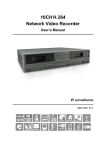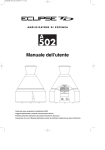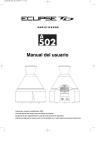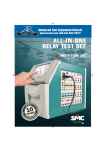Download Ramsey Electronics SHA2 Instruction manual
Transcript
BINARY 4 to 16 LINE DECODER Ramsey Electronics Model No. B D 1 2 4 8 4 1 6 0 1 2 3 4 5 6 7 8 9 10 11 12 13 14 15 BD416 The BD416 provides a simple 4 line BCD (Binary-Coded-Decimal) to one of 16 line output decoder. This is useful if you need to control up to 16 devices and only have 4 lines available. The outputs can control a 5 volt DC device @ up to 20mA. Input levels are 5 volt active high logic levels. User configurable latched/non-latched, and set/reset latched output plus active high or low data valid strobe. The BD416 can be used as a building block in many applications. Let your imagination fun wild. • 5 volt logic level BCD input to one of 16 active low outputs. • Modular design can be combined with other applications to build a full system. • 5 VDC @ 20mA active low output • Selectable Active High/Active Low valid data input strobe • Latched/non-latched data output option • Selectable set or reset state for latched mode operation BD416 • 1 PARTIAL LIST OF AVAILABLE KITS: RAMSEY TRANSMITTER KITS • FM10C, FM25B FM Stereo Transmitters • AM1C, AM25 Transmitter RAMSEY RECEIVER KITS • FR1C FM Broadcast Receiver • AR1C Aircraft Band Receiver • AR2 Aircraft Band Receiver • SR2C Shortwave Receiver • AA7C Active Antenna • SC1C Shortwave Converter RAMSEY HOBBY KITS • SG7 Personal Speed Radar • SS70C Speech Scrambler/Descrambler • TT1CTelephone Recorder • MD3C Microwave Motion Detector • PH14C/15C/16C Peak hold Meters RAMSEY AUDIO KITS • SHA1C and SHA2 Headphone Amplifier kits • UAM4 40 Watt Stereo Amplifier kit RAMSEY AMATEUR RADIO KITS • HR Series HF All Mode Receivers • DDF1 Doppler Direction Finder Kit • QRP Series HF CW Transmitters • CW7C CW Keyer • QRP Power Amplifiers RAMSEY MINI-KITS Many other kits are available for hobby, school, scouts and just plain FUN! New kits are always under development. Write, call or visit www.ramseykits.com for our free Ramsey catalog. BD416 Ramsey Electronics publication No. BD416 First Printing: May 2010 COPYRIGHT ©2009 by Ramsey Electronics, LLC. 590 Fishers Station Drive, Victor, New York 14564. All rights reserved. No portion of this publication may be copied or duplicated without the written permission of Ramsey Electronics, LLC. Printed in the United States of America. BD416 • 2 Ramsey Publication No. BD416 Manual Price Only $5.00 INSTRUCTION MANUAL FOR BINARY 4 to 16 LINE DECODER TABLE OF CONTENTS Introduction/Circuit Description....................... 2 Parts Layout Diagram ..................................... 7 Schematic ....................................................... 8 “Learn-As-You-Build” Kit Assembly .............. 10 Parts List ....................................................... 11 Assembly Steps ............................................ 12 Conclusion .................................................... 14 Specifications................................................ 14 Ramsey Kit Warranty .................................... 15 RAMSEY ELECTRONICS, LLC 590 Fishers Station Drive Victor, New York 14564 Phone (585) 924-4560 Fax (585) 924-4555 www.ramseykits.com BD416 • 3 Introduction The BD416 is a simple 4 line binary input to one of 16 lines output interface. The output can be configured to latch the output when a valid data signal is applied. The valid data signal may be either an active high or active low logic level input. In the latched output configuration the output may be set to initialize to a set, output line “0” low, or reset, output line “15” low, state at power-up. In non-latched configuration the output initializes to match the input binary setting on power-up and simply follows the input. The binary input is active high 5 volt logic level. BD416 Circuit Operation If you look on the left side of the schematic you will see the 4 binary input lines, B0, B1, B2, B3 and “VALID DATA”. The input may be applied to J1, J2 and/or J5. First we’ll discuss the non-latched configuration. A binary code is applied to B0 thru B3. These 4 lines are applied to U4 pins 3, 6, 10 and 13 respectively. U4 is a quad 2 input multiplexer which means it’s like 4, SPDT switches. It simply selects one of the input signals on each switch. The switches are controlled by the “SEL” signal, U4 pin 1. With a high level applied to U4 pin 1, that’s when no jumper is installed on “LATCH” jumper H2, the signals applied to the BD416 inputs are directly selected. The outputs of U4 are pins 4, 7, 9 and 12 and are connected to U3 pins 10,21, 22 and 23 respectively. U3 is a 4 line to 16 line decoder. It decodes the 4 binary input lines to one of 16 output lines just like it’s name suggests. Only one of the 16 output lines is low according to the binary code applied to the inputs. This is probably a good time to explain a little about binary signals. A binary signal has only two conditions. It can be either a high level, usually called a “1”, or it can be a low level usually called a “0”. Since we need to be able to represent 16 conditions and have only two levels to work with we will need 4 separate binary signal lines. Since most of us are use to the decimal, or 10’s base counting system we’ll assign each of the 4 binary lines a value. For the BD416 input B0 will have a value of 1, B1 will equal 2, B2 will be 4 and B3 will equal 8. In order to figure out what the input signal value is in decimal all you need to do is add the above values of each line that is set to a 1 together. So if B3 = 0, B2 = 1, B1 = 0 and B1 = 1 the decimal value will be 0 + 4 + 0 + 1 which equals 5 and output 5 will be low. A binary representation of this value is written in the order, B3, B2, B1, B0 or “0101” for this example. For another example the decimal number 9 would be written as “1001” in binary. Just add 8 + 0 +0 +1 = 9. A table listing all 16 input and output combinations is given in TABLE 1 below. BD416 • 4 TABLE 1: BD416 INPUT/OUTPUT INPUT B B B B 3 2 1 0 0 0 0 0 0 OUTPUT 1 2 3 4 5 6 7 8 9 1 0 1 1 1 1 1 1 1 1 1 1 1 1 1 1 2 1 1 3 1 1 4 1 1 5 1 0 0 0 1 1 0 1 1 1 1 1 1 1 1 1 1 1 1 1 1 0 0 1 0 1 1 0 1 1 1 1 1 1 1 1 1 1 1 1 1 0 0 1 1 1 1 1 0 1 1 1 1 1 1 1 1 1 1 1 1 0 1 0 0 1 1 1 1 0 1 1 1 1 1 1 1 1 1 1 1 0 1 0 1 1 1 1 1 1 0 1 1 1 1 1 1 1 1 1 1 0 1 1 0 1 1 1 1 1 1 0 1 1 1 1 1 1 1 1 1 0 1 1 1 1 1 1 1 1 1 1 0 1 1 1 1 1 1 1 1 1 0 0 0 1 1 1 1 1 1 1 1 0 1 1 1 1 1 1 1 1 0 0 1 1 1 1 1 1 1 1 1 1 0 1 1 1 1 1 1 1 0 1 0 1 1 1 1 1 1 1 1 1 1 0 1 1 1 1 1 1 0 1 1 1 1 1 1 1 1 1 1 1 1 1 0 1 1 1 1 1 1 0 0 1 1 1 1 1 1 1 1 1 1 1 1 0 1 1 1 1 1 0 1 1 1 1 1 1 1 1 1 1 1 1 1 1 0 1 1 1 1 1 0 1 1 1 1 1 1 1 1 1 1 1 1 1 1 0 1 1 1 1 1 1 1 1 1 1 1 1 1 1 1 1 1 1 1 1 0 0 OK, now it gets a little more interesting. We’re going to look at the latched configuration operation. Everything starts off just like the non-latched configuration except now U4 is set up to select the other 4 inputs on pins 2, 5, 11 and 14 by placing a jumper on the “LATCH” configuration jumper block. These inputs are connected to the “Q” outputs of 4 circuits called “D” flip-flops, 2 each in U1 and U5. Yea, I know what you may want to know now, what the heck is a “D” flip-flop? Well here’s a hopefully easy to understand explanation. A “flip-flop” is, as it’s name suggests, a device, in this case a logic circuit, that has one of two output states that can be can be “flipped” between either a high or low by a logic signal. In other words it can be “flipped” back and forth between the two states or “flip-flopped”. In the case of our application the flipflops are a special type where the output is set to the same state as an input which is called the “D” input. A trigger signal, called a clock, determines when the output assumes the state of the “D” input. The flip-flops used in the BD416 actually have 2 outputs called “Q” and “Qnot”, (“Qnot” is indicated by a Q with a line over it in the schematic), and we only use the “Q” output. These outputs BD416 • 5 are always in opposite states. Our flip-flops also have set and reset controls. When the set control is pulsed low and returned to a high level the “Q” output is set to a high level. If reset is pulsed low and returned high the “Q” output is set to a low level. We’ll talk more about these signals later. The same inputs, B0 thru B3, are connected to the “D inputs, pins 2 and 12 of U1 and U5, of the 4 “D” flip-flops. The clock, or trigger, inputs of these flipflops, pins 3 and 11 on U1 and U5, are connected to U2 pin 3. U3 is called an “exclusive or” gate which has 2 inputs. An “OR gate” simply sets it’s output to a high level if either or both of it’s inputs is high. Since this is a special type of “OR” gate called an “exclusive OR” it will only set it’s output high when only one of it’s inputs is high. If both inputs are high it’s output will be set low. This is very useful because if one of it’s inputs is locked to a high it will set it’s output to the opposite state of the other input. What’s so great about that you ask? Well read on and you’ll see what we use it for. Notice that U2 pin 2 is connected to the “VALID DATA” input and pin 1 is connected to a high level by R1. Also notice that pin 1 is connected to jumper H1. By placing a jumper on H2, U2 pin 3 will follow the “VALID DATA” input. If the jumper is removed pin 3 will be the opposite level of the “VALID DATA” input. In this way the BD416 can be configured to latch the input data into the “D” flip-flops on either a low or high level “VALID DATA” signal. By setting up the data on the input lines B0 – B3 and then triggering that data into the flipflops using the “VALID DATA” input the 16 output lines will be set and latched to the data value placed on the inputs. It will remain in that state until another “VALID DATA” signal latches in another input value. The last operation we need to look at is the “SET” and “RESET” operation of the flip-flops. “INIZALIZE” jumper H3 is used to determine how the outputs are set up when power is applied in the latched configuration. When power is first applied to the BD416 capacitor C6 is discharged and this is a low logic level and can be applied to either the set, pins 1 and 13, or reset, pins 4 and 10, of U1 and U5 by the placement of the “INITIALIZE” jumper H3. A short time after power is applied, C6 will rise to a high level and allow the flip-flops to operate as described above. If “SET” is selected the “Q” outputs of U1 and U5 will all be set to 0 and output “O” will be set to a low state. If “RESET” is selected the “Q” outputs of U1 and U5 will all be set to 1 and output “15” will be set to a low state. The BD416 requires a power supply level of 5VDC to operate. This power is applied to either J3 or J6 terminal blocks. If you are using multiple Ramsey interface modules or other products requiring 5VDC power you may feed the power thru the DB4-16 module using J3 and J6. BD416 • 6 PARTS LAYOUT DIAGRAM BD416 • 7 RAMSEY “LEARN-AS-YOU-BUILD” ASSEMBLY STRATEGY Be sure to read through all of the steps, and check the boxes as you go to be sure you didn't miss any important steps. Although you may be in a hurry to see results, before you switch on the power check all wiring and capacitors for proper orientation. Also check the board for any possible solder shorts, and/or cold solder joints. All of these mistakes could have detrimental effects on your kit - not to mention your ego! Kit building tips: Use a good soldering technique - let your soldering iron tip gently heat the traces to which you are soldering, heating both wires and pads simultaneously. Apply the solder on the iron and the pad when the pad is hot enough to melt the solder. The finished joint should look like a drop of water on paper, somewhat soaked in. Mount all electrical parts on the top side of the board provided. The top side is clearly marked with the word “TOP”, you can’t miss it. This is the side that has little or no traces on it, but is covered with mostly copper. When parts are installed, the part is placed flat to the board, and the leads are bent on the backside of the board to prevent the part from falling out before soldering (1). The part is then soldered securely to the board (2-4), and the remaining lead length is then clipped off (5). Notice how the solder joint looks on close up, clean and smooth with no holes or sharp points (6). Warning: Use only rosin core solder or solder designed to be used with electronic equipment. Use of acid core solder will void your warranty and produce a board that will disintegrate in a short period of time. BD416 • 10 PARTS LIST Resistors 4-10K ohm (brown-black-orange), R1, R2, R3, R4 Capacitors 2-10uF C6, C7 (10uF, 35V) 5-0.1uF C1, C2, C3, C4, C5 (104) Connectors 1-20 pin dual row J4 1-10 pin dual row J5 1-3 pin H3 2-2 pin H1, H2 2-3 screw terminal J1, J2 2-2 screw terminal J3, J6 Semiconductors 2-74HC74 dual D flip-flop, U1, U5 1-74HC157 quad 2 input multiplexer, U4 1-74HC154 4 to 16 line decoder, U3 1-74HC86 quad XOR gate, U2 Miscellaneous 3-jumper blocks 1-Printed circuit board BD416 • 11 ASSEMBLY STEPS We’ll start with the low profile components and work our way to the tallest. That will make it easier to install and solder the components. Locate the 5 IC’s, (2x74HC74, 1x74HC154,1x74HC154 1x74HC86). These IC’s may have letters before and/or after the type depending on the supplier. Be assured they are the correct part if they have the stated number in the labeling. Notice that the marking on the board for these IC’s has a small half circle on one end and that the IC’s have the same type of marking or a small indented dot on one end. It is important that the IC be installed so it matches the marking on the board. It may be necessary to gently bend the leads inward on each side of the IC’s so they are at right angles with the plastic body in order to get them into the holes in the board. This is easily done by holding the IC so the leads on one side are flat against a flat surface and then pressing the body so the leads bend slightly inward. Do this for the leads on both sides of the IC. Make sure that all the leads go thru the board. When you install the IC it is a good idea to insert it into the board and slightly bend one lead on opposite corners on the bottom of the board so it will stay in place. Then make sure all leads are thru and it is properly oriented before soldering all the leads. 1. 2. 3. 4. 5. Install U1, a 74HC74 Install U2 a 74HC74. Install U3, a 74HC154. Install U4, a 74HC157. Install U5, a 74HC86. Next locate the 4, 10K ohm resistors. 6. 7. 8. 9. Install 10K ohm resistor R1 [brown, black, orange]. Install 10K ohm resistor R2 [brown, black, orange]. Install 10K ohm resistor R3 [brown, black, orange]. Install 10K ohm resistor R4 [brown, black, orange]. Now find the 4 screw terminal connectors, (2, 2position and 2, 3 position). 10. 11. 12. 13. Install J1 a 3 position connector. Install J2 a 3 position connector. Install J3 a 2 position connector. Install J6 a 2 position connector. Locate the 10 pin dual row and 20 pin dual row connectors, (one of each) 14. Install J5 a 10 pin dual row connector. 15. Install J4 a 20 pin dual row connector. BD416 • 12 Next find the 3 pin header and two(2) two pin headers. 16. Install H1 a 2 pin header.. 17. Install H2 a 2 pin header. 18. Install H3 a 3 pin header. This is the home stretch. Locate the 2, 10uF capacitors and 5, 0.1uF capacitors. 19. 20. 21. 22. 23. Install C1, a 0.1uF capacitor, (marked 104) Install C2, a 0.1uF capacitor, (marked 104) Install C3, a 0.1uF capacitor, (marked 104) Install C4, a 0.1uF capacitor, (marked 104) Install C5, a 0.1uF capacitor, (marked 104) The next two capacitors MUST be installed with the lead marked with a stripe and/or “-“ in the hole opposite the “+” printed on the board. 24. Install C6, a 10uF capacitor, watch polarity. 25. Install C7, a 10uF capacitor, watch polarity. That’s it. Your BD416 is done. All that’s left is to do a final visual check of all our work. Verify that all the IC’s are properly installed, there are no solder bridges and that all solder connections are good and you can start using your decoder. BD416 • 13 If you enjoyed this Ramsey product, there are plenty more to choose from in our catalog - visit our website at http://www.ramseyelectronics.com or call today! CONCLUSION We sincerely hope that you will enjoy the use of this Ramsey product. As always, we have tried to compose our manual in the easiest, most “user friendly” format possible. As our customers, we value your opinions, comments, and additions that you would like to see in future publications. Please submit comments or ideas to: Ramsey Electronics, LLC. Attn. Hobby Kit Department 590 Fishers Station Drive Victor, NY 14564 or email us at: [email protected] And once again, thanks from the folks at Ramsey! BD416 SPECIFICATIONS Input Requirements: Power: Logic: 5VDC 4 BCD lines, 5V active high Output Configuration: Open collector, active low, 1 of 16 lines Output: 5VDC max @ 20mA max Dimensions: Board: Mounting: Weight: 2.5”(W) X 3.82” (L) 63.5mm (W) X97mm (L) 4 holes, 4/40 screw clearance on 2” x 3” pattern 4 holes on 50.8mm x 76.3mm pattern 0.7 Oz, 0.0198 Kg BD416 • 14 THE RAMSEY KIT WARRANTY 1. GENERAL: Notice that this is not a "fine print" warranty. We want you to understand your rights and ours too! All Ramsey kits will work if assembled properly. The very fact that your kit includes this new manual is your assurance that prior to release of this kit, a varied group of knowledgeable people have assembled this kit from scratch using this manual. During this process, changes and additions are noted by each assembler and integrated into the final version of the manual…which you have! If you need help, please read through your manual carefully, all information required to properly build and test your kit is contained within the pages! However, customer satisfaction is our goal, so in the event that you do have a problem, please note the following: 2. DEFECTIVE PARTS: It's always easy to blame a part for a problem in your kit. Before you conclude that a part may be bad, thoroughly check your work. Today's semiconductors and passive components have reached incredibly high reliability levels, and it’s sad to say that our human construction skills have not! But on rare occasions a sour component can slip through. All of our kit parts carry the Ramsey Electronics Warranty that they are free from defects for a full ninety (90) days from the date of purchase. Defective parts will be replaced promptly at our expense. If you suspect any part to be defective, please mail it to our factory for testing and replacement. Please send only the defective part(s), not the entire kit. The part(s) MUST be returned to us in suitable condition for testing. Please be aware that testing can usually determine if the part was truly defective or damaged by assembly or usage. Don't be afraid of telling us that you “damaged it” or “burned it out”, we're all human and in most cases, replacement parts are very reasonably priced. Remember, our goal for over three decades is to have a happy customer, and we’re here to work WITH you, not AGAINST you! 3. MISSING PARTS: Before assuming a part value is missing, check the parts listing carefully to see if it is a critical value such as a specific coil or IC, or whether a RANGE of values is suitable for the component (such as a "100 to 500 uF capacitor"). Often times, common sense will solve a mysterious missing part problem. If you're missing five 10K ohm resistors and received five extra 1K resistors, you can pretty much be assured that the “1K ohm” resistors are actually the “missing” 10 K parts ("Hum-m-m, I guess the orange band really does look red!") Ramsey Electronics project kits are packed with pride in the USA by our own staff personnel. While separate QC checks are made on all product kits, we too are human, and once in a great while there is a chance something can get through those checks! If you believe we packed an incorrect part or omitted a part clearly indicated in your assembly manual for your Ramsey kit, please contact us with information on the part you need. Contact our Repair Department via telephone, email or writing. Please have your invoice number and date of purchase handy. 4. REFUNDS: All Ramsey products, kit or factory assembled units have an unconditional 10 day (from the date of purchase) return policy to examine our products. If you are not satisfied for any reason, you may return your unassembled kit with all the parts and instructions, or your factory assembled and tested product, together with your proof of purchase to the factory for a full refund less shipping. The return package should be packed securely. Insurance and tracking is highly recommended. A reminder, this applies to unassembled kits. They must be in the same new condition as received, not partially assembled! Assembled kits cannot be returned for credit. No RMA’s are required; simply return to Ramsey Electronics LLC, Attn: Product Returns, 590 Fishers Station Drive, Victor, NY, 14564. If you have any questions, please contact us at 585-924-4560. 5. FACTORY REPAIR OF ASSEMBLED KITS: Most of us at Ramsey are technically oriented and we do realize that things happen! Even following the best practices, with all of the best intentions, there is that chance that your kit doesn’t work when you have completed it. Each manual goes into detailed troubleshooting based on the specific kit to help you troubleshoot the problem. We have found that 95% of returned kits involved wrongly installed components (wrong part or backwards polarity). This section of the warranty assumes you have gone through all those steps, and have now reached the point that you need to send it back. To qualify for factory repair of customer assembled kits, the following conditions apply: 1. Kits must not be assembled with acid solder flux 2. Kit boards or circuits must not be modified in any manner from the version received 3. Kits must be fully assembled, not partially assembled. Our warranty does not include “finishing” your kit! 4. Must include a full description of the problem encountered including the troubleshooting steps you have already done. 5. Must not include non-standard, non-Ramsey accessories, cases, enclosures, knobs, etc. or any batteries. 6. Must include the minimum repair fee of $25 USD in the form of check, money order or credit card authorization. 7. Ramsey Electronics, LLC reserves the right to refuse any repair due to excessive errors in construction methods. 8. If, due to customer construction methods, the repair is estimated to exceed the minimum flat rate, Ramsey Electronics, LLC will contact the customer to discuss the repairs needed and to receive authorization and payment for repair prior to repair. 9. In the unlikely case that a defective part is found to be the cause of the problem, the repairs will be made at no-charge to the customer, and any payments received for repair will be returned or credited back to the customer. 10. Properly pack your kit, insure the package, and use a carrier that can be tracked. Ramsey Electronics, LLC is not responsible for any loss or damage in shipment. Send the package together with your repair fee to the return address below. No RMA is required. 6. FACTORY REPAIR FEES: Please understand that our Tech Support Group personnel are not volunteers! They are a dedicated group of highly trained technicians each configured with a very properly equipped test bench. Upon receipt of a repair, the setup, testing, diagnosis, repair, paperwork, and repacking of your kit requires nearly an hour of their time regardless of the size or complexity of the kit! The minimum repair fee represents ½ hour Tech Support time at $50/hour USD. We try to keep all kit repairs within the realm of the $25 flat rate whenever possible…and trust us; we exceed that time spent on most kits received more often than not! 7. CONTACT INFORMATION AND RETURN ADDRESS: Technical Questions RAMSEY ELECTRONICS, LLC Attn: Tech Support BD416 590 Fishers Station Drive Victor, NY 14564 585-924-4560; 585-924-4886 Fax [email protected] Product Repair & Returns • 15 RAMSEY ELECTRONICS, LLC Attn: Repairs 590 Fishers Station Drive Victor, NY 14564 585-924-4560; 585-924-4886 Fax [email protected] Quick Reference Introduction/Circuit Description .......................2 Parts Layout Diagram .....................................7 Schematic........................................................8 Parts List ...................................................... 11 Assembly Steps............................................ 12 Specifications ............................................... 14 REQUIRED TOOLS • Soldering Iron • Thin Rosin Core Solder • Needle Nose Pliers • Small Diagonal Cutters ADDITIONAL SUGGESTED ITEMS Helping Hands Holder for PC Board/ Parts • Desoldering Braid • RAMSEY ELECTRONICS, LLC 590 Fishers Station Drive Victor, New York 14564 Phone (585) 924-4560 Fax (585) 924-4555 www.ramseykits.com Ramsey Publication No. BD416 Assembly and Instruction manual for: BINARY 4 to 16 LINE DECODER BD416 • 16

























